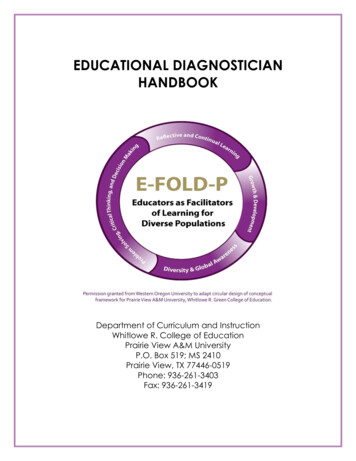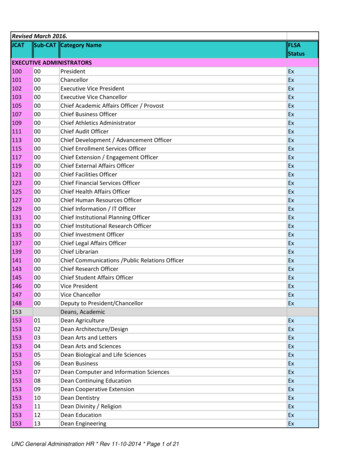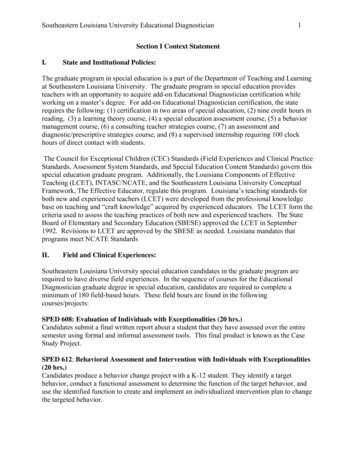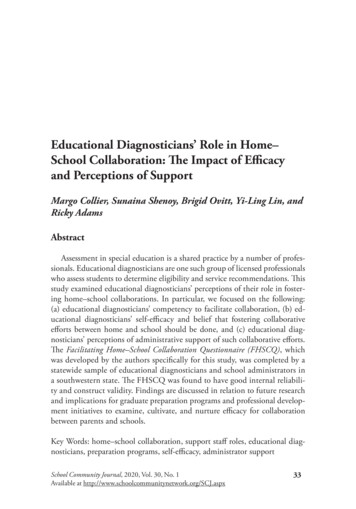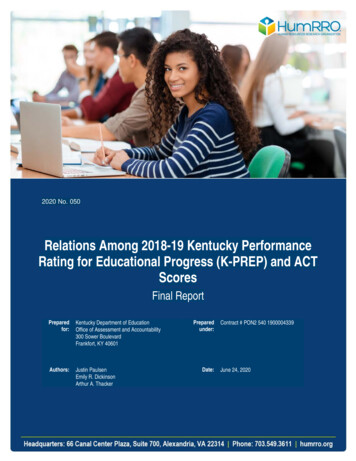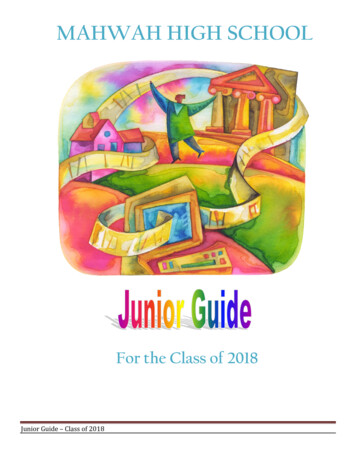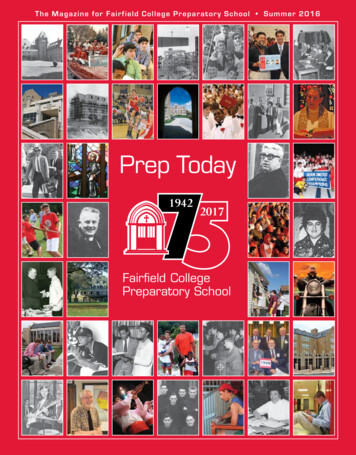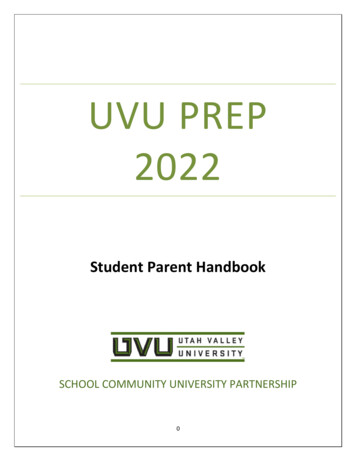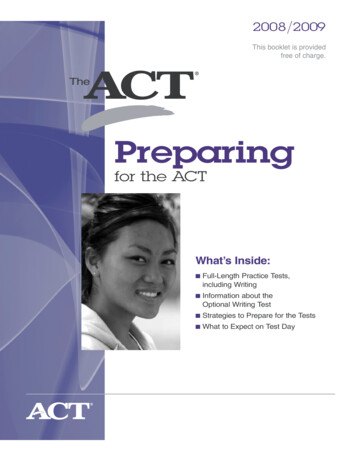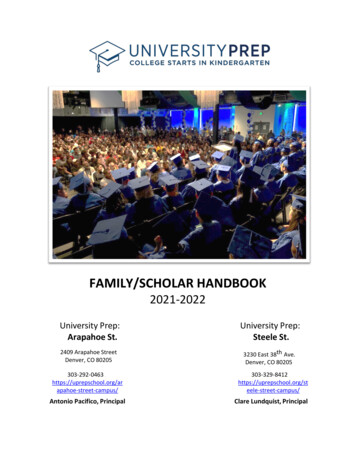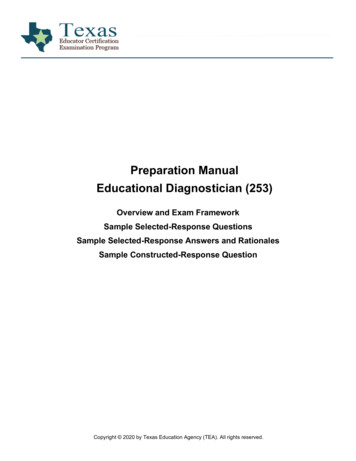
Transcription
Preparation ManualEducational Diagnostician (253)Overview and Exam FrameworkSample Selected-Response QuestionsSample Selected-Response Answers and RationalesSample Constructed-Response QuestionCopyright 2020 by Texas Education Agency (TEA). All rights reserved.
Preparation ManualSection 3: Overview and Exam FrameworkEducational Diagnostician (253)Exam OverviewExam NameEducational DiagnosticianExam Code253Time5 hoursNumber of Questions90 selected-response questions and 1 constructed-response questionFormatComputer-administered test (CAT)The TExES Educational Diagnostician (253) exam is designed to assess whether an examinee has the requisiteknowledge and skills that an entry-level educator in this field in Texas public schools must possess. The 90 selectedresponse questions and the 1 constructed-response question are based on the Educational Diagnostician examframework. Questions on this exam range from grades EC–12. Your final scaled score will be based only on scoredquestions.The StandardsStandard IThe educational diagnostician understands and applies knowledge of thepurpose, philosophy, and legal foundations of evaluation and specialeducation.Standard IIThe educational diagnostician understands and applies knowledge of ethicaland professional practices, roles, and responsibilities.Standard IIIThe educational diagnostician develops collaborative relationships withfamilies, educators, the school, the community, outside agencies, and relatedservice personnel.Standard IVThe educational diagnostician understands and applies knowledge of studentassessment and evaluation, program planning, and instructional decisionmaking.Standard VThe educational diagnostician knows eligibility criteria and procedures foridentifying students with disabilities and determining the presence of aneducational need.2
Standard VIThe educational diagnostician selects, administers, and interprets appropriateformal and informal assessments and evaluations.Standard VIIThe educational diagnostician understands and applies knowledge of ethnic,linguistic, cultural, and socioeconomic diversity and the significance of studentdiversity for evaluation, planning, and instruction.Standard VIIIThe educational diagnostician knows and demonstrates skills necessary forscheduling, time management, and organization.Standard IXThe educational diagnostician addresses students’ behavioral and socialinteraction skills through appropriate assessment, evaluation, planning, andinstructional strategies.Standard XThe educational diagnostician knows and understands appropriate curriculaand instructional strategies for individuals with disabilities.Domains and CompetenciesApprox.Percentageof ExamStandards AssessedDomainDomain TitleIIdentification and Assessment34%I, III–VII, XIICurriculum, Instruction, and Intervention23%IV–VII, IX, XIIIProfessional Responsibilities23%I–IV, VIIIIVAnalysis and Response20%II, IV–VI, XThe content covered by this exam is organized into broad areas of content called domains. Each domain covers oneor more of the educator standards for this field. Within each domain, the content is further defined by a set ofcompetencies. Each competency is composed of two major parts:3
The competency statement, which broadly defines what an entry-level educator in this field in Texaspublic schools should know and be able to do. The descriptive statements, which describe in greater detail the knowledge and skills eligible for testing.Domain I—Identification and AssessmentCompetency 001—(Identification for Special Education Evaluation and Services): Apply knowledge of requirements foridentifying students who meet disability criteria and for determining the need for specially designed instruction andrelated services.For example:A. Demonstrate knowledge of federal and state criteria and identification procedures for determiningstudents' eligibility for special education services, including all components of Child Find mandaterequirements.B. Apply knowledge of the educational diagnostician's role in assisting local educational agencies (LEAs) incomplying with Child Find.C. Apply knowledge of risk factors, characteristics of disabilities, and other indications that a student mayhave a need for specially designed instruction and related services.D. Demonstrate knowledge of issues related to the identification of and the overrepresentation andunderrepresentation in special education of culturally and linguistically diverse student populations.E. Demonstrate knowledge of important student information needed (e.g., cognitive, academic,communicative, social, physical, functional, adaptive, and emotional characteristics) from a variety ofsources, including information regarding students' educational, developmental, medical, and familyhistories.F. Demonstrate knowledge of the relationships between assessment and evaluation, goals and objectives,and services for students with disabilities.Competency 002—(Evaluation, Planning, Selection, and Administration): Apply knowledge of the functions and principlesof assessment, assessments used to make educational and instructional decisions about students, and procedures andconsiderations in selecting and administering appropriate formal and informal assessments for individual students.For example:A. Demonstrate knowledge of terminology and statistical concepts used in assessment and evaluation (e.g.,data distributions, measures of central tendency).B. Demonstrate knowledge of standards for test norming, reliability, and validity; procedures used inadministering and scoring assessment instruments; and sources of measurement error and potentialbias.C. Apply knowledge of the uses and limitations of various types of assessment instruments (e.g., normreferenced, criterion-referenced) and observation techniques (e.g., anecdotal, frequency, temporal) toidentify students with disabilities and determine the presence of an educational need.D. Demonstrate the ability to choose relevant and appropriate assessments based on the technical qualityof the instruments, referral concerns, data needed to make decisions, and individual studentcharacteristics (e.g., ethnic, cultural, linguistic, age, or socioeconomic factors), and demonstrateknowledge of how to ensure fairness and equity in assessment results.4
E. Apply knowledge of targeted individualized assessment strategies to inform instruction (e.g., authenticassessment, contextual assessment, curriculum-based assessment, progress monitoring, teacherobservations, student feedback).F. Apply knowledge of methods used for academic and nonacademic assessments (e.g., vocational,developmental, behavioral, assistive technology, motor skills).G. Demonstrate understanding of procedures for student screening; prereferral, including Response toIntervention (RtI) and multi-tiered support; referral; and eligibility.H. Apply knowledge of administration and scoring procedures for various standardized assessments (e.g.,basal, ceilings, testing the limits) and nonstandardized assessments.I.Apply knowledge of procedures and strategies for effectively collaborating with families and with otherprofessionals in assessing and evaluating students with disabilities.Competency 003—(Interpretation and Reporting of Evaluation Results): Apply skills for interpreting, reporting,and communicating the results of the Full and Individual Initial Evaluation (FIIE).For example:A. Demonstrate knowledge of the uses and limitations of various types of formal and informal assessmentand evaluation data.B. Demonstrate knowledge of the appropriate application and interpretation of derived scores (e.g., standardscores, percentile ranks, age and grade equivalents, stanines, T-scores, z-scores).C. Apply knowledge of cultural and linguistic diversity in making appropriate evaluation and interpretationdecisions.D. Apply performance data (including prereferral data) and information from teachers, other professionals,student, and parents/guardians to make appropriate educational recommendations within learningenvironments and to determine the effectiveness of instruction, modifications, and/or accommodations.E. Apply knowledge of strategies for effectively communicating to parents/guardians, classroom teachers,and other professionals about assessment purposes, assessment methods, and the implications anduses of assessment results.F. Analyze the need for further student assessment, adjustment of services, and/or evaluation asappropriate, including assessments conducted by other professionals, in specific areas (e.g., languageskills, social skills, physical skills, emotional skills, assistive technology needs).G. Apply knowledge of components required to create Full and Individual Initial Evaluation (FIIE) reportsaccording to federal and state guidelines.Domain II—Curriculum, Instruction, and InterventionCompetency 004—(Academic Instruction and Strategies): Apply knowledge of educational implications of disabilities,appropriate curricula, and instructional strategies, including accommodations, modifications, and interventions, forstudents with disabilities.For example:A. Apply knowledge of characteristics and educational implications of disabilities for students of differentages, in various environments, and from culturally and linguistically diverse populations.B. Demonstrate knowledge of evidence-based instruction and curricula for the development of individualstudents' academic skills within the continuum of services in the least restrictive environment (LRE).5
C. Demonstrate knowledge of targeted instructional strategies, technology, and curriculum materials toaddress the individual needs of students with disabilities within the continuum of services.D. Apply knowledge of making individualized recommendations to assist the Admission, Review, andDismissal (ARD) committee in developing appropriate and ambitious Individualized Education Programs(IEPs) that target students' individual academic needs and goals.E. Demonstrate general knowledge of how to create, monitor the progress of, and collect data fromappropriate, nonbiased, and culturally responsive interventions to assist in the ongoing appraisal ofstudents' academic growth.F. Analyze individual results of assessments, evidence-based practices, interventions, and previousrecommendations to assist with making decisions about individualized instruction for students.Competency 005—(Functional Skill Instruction and Strategies): Understand the use of appropriate assessment,evaluation, planning, and instructional strategies for developing students' social, behavioral, communication, andadaptive skills.For example:A. Apply knowledge of functional skills (e.g., social, behavioral, communication, adaptive) that studentsneed in order to participate in and contribute effectively to their school, home, community, and workenvironments.B. Demonstrate general knowledge of appropriate, nonbiased, and culturally responsive evidence-basedinterventions, curricula, and instructional strategies for the development of functional skills based onknowledge of individual students with disabilities.C. Demonstrate knowledge of the effects of antecedents and consequences (e.g., environment, teacherattitudes and behaviors) on the behavior of students with disabilities.D. Analyze assessment and evaluation results in collaboration with members of the multidisciplinary team(e.g., licensed specialists in school psychology [LSSPs], special education teachers, related serviceproviders) in addressing educationally relevant behavior (e.g., vocational, functional, academic, social)for students in various settings.E. Apply knowledge of requirements and procedures for functional behavioral assessments (FBAs),manifestation determination reviews, and behavioral intervention plans (BIPs) that incorporate positivebehavioral supports and interventions.F. Apply knowledge of functional skills instruction for transitioning across environments (e.g., preschool toelementary school, school to work) and the supports needed for transition and integration into variousprogram placements.G. Apply knowledge of key concepts in behavior intervention (e.g., least intrusive intervention within thelearning environment, social skills curricula, cognitive behavioral strategies) and ways of applying theseconcepts in collaboration with staff across educational settings (e.g., LSSPs, special education teachers).Domain III—Professional ResponsibilitiesCompetency 006—(Consultation and Collaboration): Understand strategies and approaches for effective consultation anddevelopment of collaborative relationships with students, parents/guardians, school personnel, and other professionalsand apply skills for scheduling and management of timelines and reporting requirements.6
For example:A. Demonstrate knowledge of effective culturally responsive consultation and collaboration skills (e.g.,knowledge of family systems, parents/guardians supporting student development and educationalprogress).B. Apply understanding of the special education process to assist parents/guardians and school staff innavigating through initial referral, Individualized Education Program (IEP) development, reevaluations,transition planning, and dismissal and/or graduation.C. Apply knowledge of the roles of students with disabilities, parents/guardians, teachers, and other schooland community personnel in collaborating on and planning Individualized Education Programs (IEPs) forstudents.D. Apply knowledge of strategies for encouraging students' and families' active participation in theeducational team, addressing families' concerns, and fostering respectful and beneficial relationshipsbetween families and education professionals.E. Apply principles for maintaining accurate and detailed records of assessments, evaluations, and relatedproceedings (e.g., Full and Individual Initial Evaluation [FIIE], Admission, Review, and Dismissal[ARD]/Individualized Education Program [IEP] meetings, parent/guardian communications andnotifications).F. Apply knowledge of legal and regulatory timelines, schedules, and reporting requirements; methods formaintaining eligibility folders; and strategies for organizing, maintaining, accessing, and storing records.Competency 007—(Legal and Ethical Practice): Apply knowledge of professional practices, roles, and responsibilities andthe legal and ethical foundations of evaluation related to special education.For example:A. Demonstrate knowledge of models and theories that provide the basis for special education evaluationsand recognize the purpose of evaluation procedures and their relationship to educational programming.B. Apply knowledge of state and federal laws, rules, and regulations related to the roles and activities of theeducational diagnostician, including the assessment and evaluation of individuals with educational needsand compliance with local, state, and federal monitoring and evaluation requirements.C. Apply knowledge of issues, assurances, and due process rights related to evaluation, eligibility, andplacement within a continuum of services (e.g., least restrictive environment) and of effectivecommunication with parents/guardians on these issues.D. Demonstrate knowledge of Admission, Review, and Dismissal (ARD)/Individualized Education Program(IEP) processes, rules, and procedures as determined by state and federal regulations.E. Demonstrate knowledge of the rights and responsibilities of parents/guardians, schools, students,teachers, and other professionals in relation to students' individual learning needs.F. Apply knowledge of professional ethical practices (e.g., in relation to confidentiality, informed consent,placement, and state accountability measures).G. Demonstrate knowledge of qualifications necessary to administer and interpret various assessmentinstruments and procedures for consistent use of these instruments across instructional settings.H. Demonstrate knowledge of organizations and publications relevant to the field of educational diagnosisand recognize the importance of engaging in activities that foster professional competence and benefitindividuals with exceptional learning needs, their families, and/or colleagues.7
Domain IV—Analysis and ResponseCompetency 008—(Analysis and Response): In a written response, analyze qualitative and quantitative data to identify agiven student's strengths and needs, provide a thorough evaluation, and determine evidence-and research-basedrecommendations for meeting the student's educational needs.For example:A. Analyze and interpret assessment information on a given student, including qualitative and quantitativeassessment data (e.g., anecdotal notes, student work samples, parent/guardian checklists) from avariety of formal and informal assessments (e.g., cognitive, academic, communicative, social, physical,functional, adaptive, emotional) to identify the student's strengths and needs, including the presence orabsence of a disability according to state and federal eligibility criteria.B. Synthesize data and information on the individual student to generate one recommendation for evidencebased instruction and/or intervention.C. Describe how a teacher would implement and monitor the progress of the recommendation.8
Preparation ManualSection 4: Sample Selected-Response QuestionsEducational Diagnostician (253)This section presents some sample exam questions for you to review as part of your preparation for the exam. Todemonstrate how each competency may be assessed, sample questions are accompanied by the competency thatthey measure. While studying, you may wish to read the competency before and after you consider each samplequestion. Please note that the competency statements do not appear on the actual exam.The sample questions are included to illustrate the formats and types of questions you will see on the exam; however,your performance on the sample questions should not be viewed as a predictor of your performance on the actualexam.Selected-Response Questions with RationalesEach sample exam question here includes the correct answer and a rationale for each answer option.Domain I—Identification and AssessmentCompetency 001—(Identification for Special Education Evaluation and Services): Apply knowledge of requirements foridentifying students who meet disability criteria and for determining the need for specially designed instruction andrelated services.1. An educational diagnostician is interviewing the parents/guardians of a second-grade student who has beenreferred for a Full and Individual Initial Evaluation (FIIE) for suspected autism spectrum disorder (ASD). Which of thefollowing anecdotal parent/guardian observations regarding the student's acquisition of developmental milestones ismost suggestive of ASD?A. "He had three ear infections before he was 12 months old."B. "He liked to line up all of his toys every morning and became very upset if anyone touched them."C. "He crawled and walked until he was 18 months old. After that, he walked but fell sometimes on unevensurfaces."D. "His favorite game was to make food for his stuffed animal toys and pretend to feed them."Answer2. A school district is working to address potential disproportionality in special education services for culturally andlinguistically diverse student populations. Which of the following actions would most effectively promote this goal?A. evaluating bilingual and multilingual students to determine special education service eligibility until theyare considered proficient in spoken EnglishB. examining the district's assessment practices for all students to determine whether the assessmentinstruments used are valid and unbiasedC. arranging for a school-based committee of educational diagnosticians and psychologists to be solelyresponsible for making special education referrals9
D. meeting with the parents/guardians of students currently receiving special education services and askingtheir perspectives on the quality of educational servicesAnswer3. A second-grade student has recently been diagnosed with attention deficit hyperactivity disorder (ADHD) by alicensed physician. Per parent request, a Full and Individual Initial Evaluation (FIIE) was conducted. Whenconsidering the student's eligibility for special education and related services, the Admission, Review, and Dismissal(ARD) committee must:A. determine that the student's academic needs are not based on the ADHD diagnosis.B. ensure that the student has received adequate instructional supports and classroom accommodations forADHD prior to determining eligibility.C. use information from multiple sources of data in determining whether the student's ADHD adverselyaffects the student's educational performance.D. show that the student is not advancing from grade to grade due to ADHD.AnswerCompetency 002—(Evaluation, Planning, Selection, and Administration): Apply knowledge of the functions and principlesof assessment, assessments used to make educational and instructional decisions about students, and procedures andconsiderations in selecting and administering appropriate formal and informal assessments for individual students.4. A kindergarten student with a disability requires frequent prompts and cues to attend to instructions and remainwithin the proximity of the teacher and peers during classroom activities. After collecting baseline behavior data, theAdmission, Review, and Dismissal (ARD) committee plans to develop an intervention plan to support the student'sability to attend and remain engaged. Which of the following sources of data would best inform the ARD committee'sdevelopment of an intervention plan?A. observing the student during specified time intervals and recording occurrences of the target behaviorB. informing the student that the student's behavior is being observed and offering praise when the studentdemonstrates prosocial behaviorC. determining an intervention method that will be implemented with the student and collecting data on theduration of the student's target behavior using that methodD. considering environmental and situational factors that are contributing to the student's behaviorAnswer5. The parents/guardians of a third-grade student who was recently diagnosed with attention deficit hyperactivitydisorder (ADHD) by a pediatrician have requested a Full and Individual Initial Evaluation (FIIE). Which of thefollowing actions would be most appropriate for the educational diagnostician to take in the evaluation process?A. obtaining written consent from the parents/guardians to request records and evaluation data from thestudent's physicianB. administering an attention deficit hyperactivity disorder rating scale to assess the student's attention,memory, and processingC. discontinuing the evaluation and using information from the student's physician to qualify the student forservices10
D. designing appropriate accommodations to help the student manage impulsivity in the classroomAnswer6. An educational diagnostician is working in conjunction with the language proficiency assessment committee(LPAC). In which of the following components of a student's evaluation would the LPAC members be most closelyinvolved?A. becoming the primary point of contact for a student's parents/guardians regarding their child's learningB. writing language-related Individualized Education Program (IEP) goals for a studentC. administering cognitive assessments to the student in a student's home languageD. making recommendations about appropriate assessments and linguistic accommodations for a studentAnswerCompetency 003—(Interpretation and Reporting of Evaluation Results): Apply skills for interpreting, reporting,and communicating the results of the Full and Individual Initial Evaluation (FIIE).7. On the Similarities and Vocabulary secondary subtests of the Wechsler Intelligence Scale for Children — FifthEdition (WISC –V), a fourth-grade student obtained scaled scores of 4. Which of the following interpretations bestdescribes the student's performance on the subtests?A. average visual spatial reasoning and attention to visual detailB. significantly below-average semantic knowledge and verbal reasoningC. slightly below-average decision making and short-term visual memoryD. above-average attention and concentrationAnswer8. When selecting assessment materials and procedures for linguistically diverse students, an educationaldiagnostician should be aware that norm-referenced evaluations are likely to:A. distinguish between limited English proficiency and disability.B. accurately identify a specific disability in English learners (ELs).C. overidentify disability even when appropriately administered.D. define the impact of the disability on learning.Answer9. An eighth-grade student with bilateral hearing aids requires a number of accommodations, such as priorityseating, daily hearing aid listening checks, and classroom adaptations, to reduce noise reverberation. The student isenrolled in general education classes and, based on classroom performance and results of state testing, isconsidered average to above average academically. In addition, the classroom teachers report no social, emotional,or behavioral concerns. Given the student's needs, which of the following educational programs would best supportthe student's access to the learning environment, instruction, and materials?A. Individualized Education Program (IEP)B. Multi-Tiered Systems of Support (MTSS)C. Section 504 plan11
D. universal design for learning (UDL)AnswerDomain II—Curriculum, Instruction, and InterventionCompetency 004—(Academic Instruction and Strategies): Apply knowledge of educational implications of disabilities,appropriate curricula, and instructional strategies, including accommodations, modifications, and interventions, forstudents with disabilities.10. An educational diagnostician is recommending an explicit and systematic intervention approach for a fifth-gradestudent with a specific learning disability in mathematics. Which of the following examples best represents explicitand systematic instruction that would allow for the student's progress to be monitored?A. The teacher pairs the student with a peer to develop a process for adding simple fractions. The studentsare encouraged to create a step-by-step guide for adding fractions to share with other students.B. The teacher displays a solution expressing the process of adding two simple fractions. The student isthen asked to add a similar fraction of comparable difficulty. The student's answer is then compared tothe fraction expression presented by the teacher.C. The teacher models several different examples of adding fractions with the student. The teacher thenencourages a student to think aloud while adding simple fractions. The teacher provides the student withcorrective feedback throughout the activity.D. The teacher verbally explains the process of adding fractions for the student. The student is theninstructed to add simple fractions while using a graphic organizer developed by the teacher outlining thenew concepts taught.Answer11. As a transition goal, an eleventh-grade student with an intellectual disability wants to independently engage in avariety of recreational activities, such as taking public transportation to go to the movies and the public library. Whichof the following data collection measures would allow most effectively monitoring of the student's progress towardthis goal?A. weekly self-assessments to monitor perceived progress toward goalsB. single-point data analysis to judge performance within specific tasksC. daily descriptive documentation outlining abilities and progressD. periodic sampling using a rubric describing criteria for each level of performanceAnswer12. Use the information below to answer the question that follows.An educational diagnostician is reviewing results from an academic achievement test recently administeredto an eighth-grade student with a specific learning disability in reading as part of the student's three-yearreevaluation. A portion of the summary is shown below.12
Subtest Score SummarySubtestPercentile RankClassificationListening Comprehension55AverageReading Comprehension5LowSentence Composition6LowWord Reading7LowEssay Composition4LowPseudoword Decoding1LowOral Expression45AverageOral Reading Fluency1LowSpelling4LowIn social studies, the student is required to participate in whole-class discussions after reading complex, grade-leveltexts, such as articles, essays, and personal accounts. Based on the student's evaluation performance, which of thefollowing accommodations would most effectively support the student's ability to participate in the whole-classdiscussions?A. offering the student extended time to complete reading assignmentsB. providing the student with a list of words and definitions associated with key discussion topicsC. activating the student's background knowledge by using small-group discussions prior to readingD. giving the student access to reading materials using text-to-speech or digital audio filesAnswerCompetency 005—(Functional Skill Instruction and Strategies): Understand the use of appropriate assessment,evaluation, planning, and instructional strategies for developing students' social, behavioral, communication, andadaptive skills.13. An educational diagnostician analyzes the following behavior data for Ellie, a second-grade student, to develop arecommendation for a replacement behavior.BehaviorEllie frequently refuses toparticipate in classroom activities.Ellie refuses to engage, oftenleaves work site, seeks negativeattention from adults, and attemptsto engage in preferred activities,such as drawing or dancing.ConsequenceThe paraprofessional typicallybrings Ellie on a walk outside ofthe classroom when behaviorsbecome too disruptive.Function of BehaviorEscape13
Which of the following recommendations would be most appropriate for th
The TExES Educational Diagnostician (253) exam is designed to assess whether an examinee has the requisite knowledge and skills that an entry-level educator in this field in Texas public schools must possess. The 90 selected-response questions and the 1 constructed-response question are based on the Educational Diagnostician exam framework.
